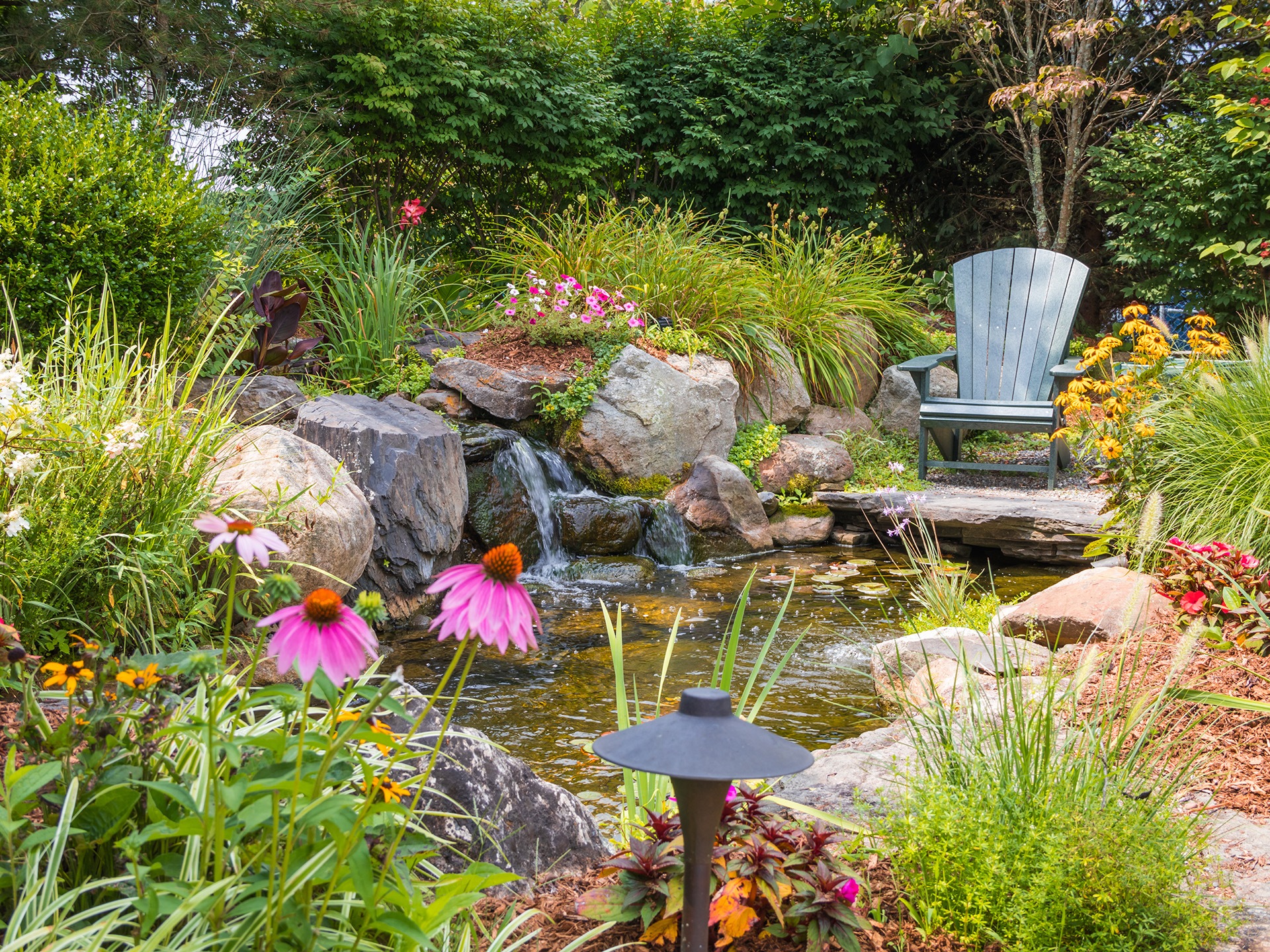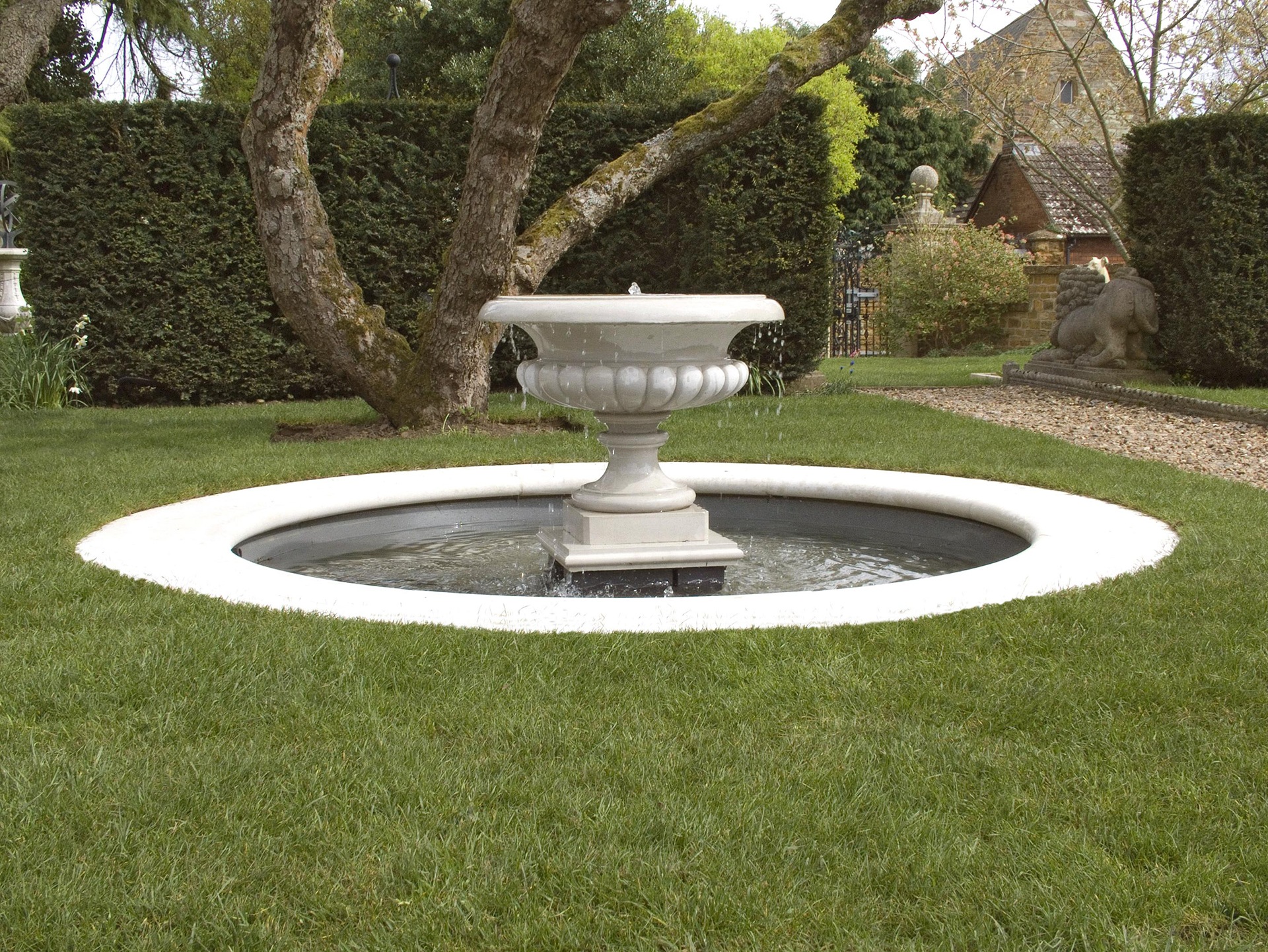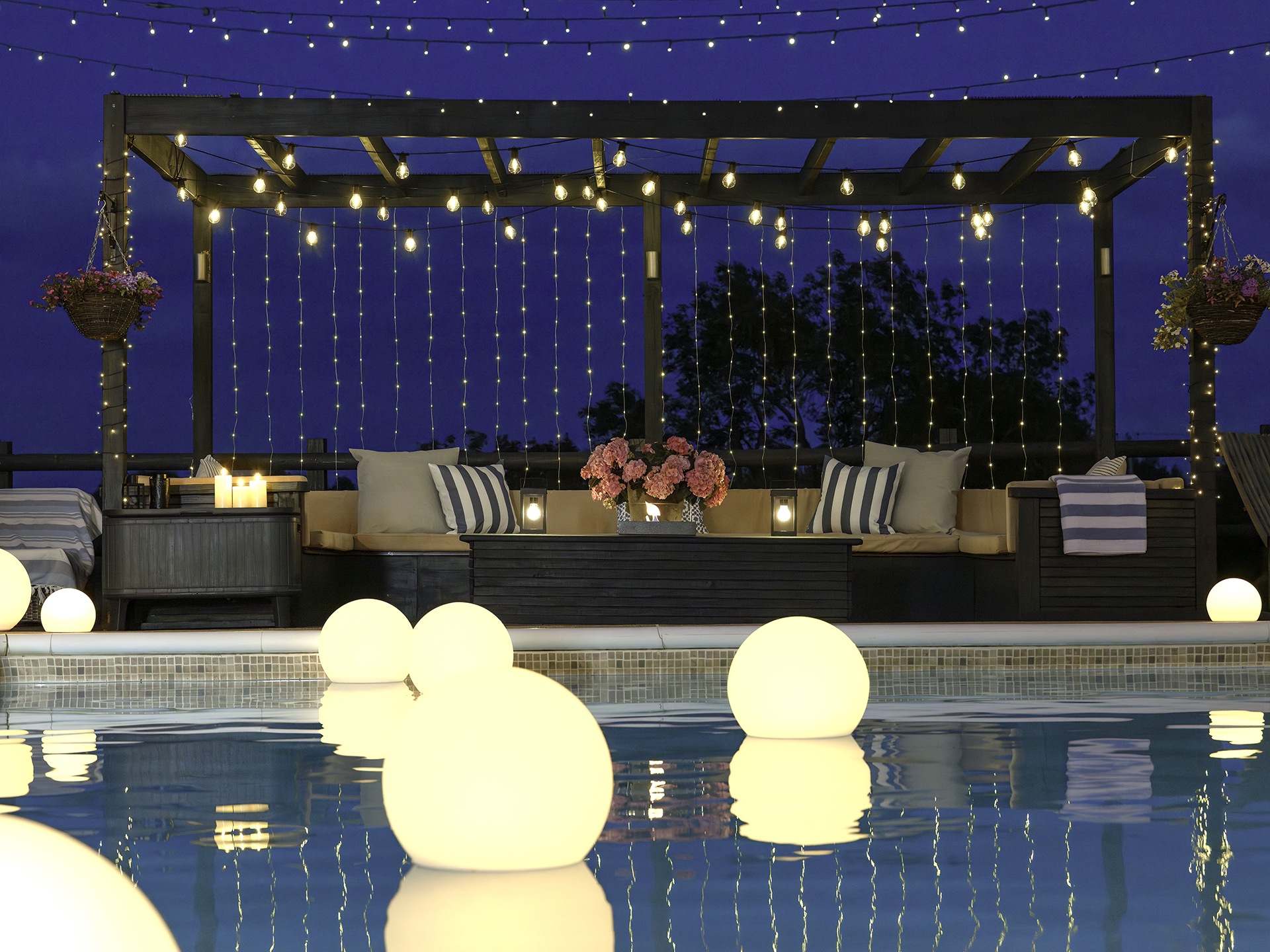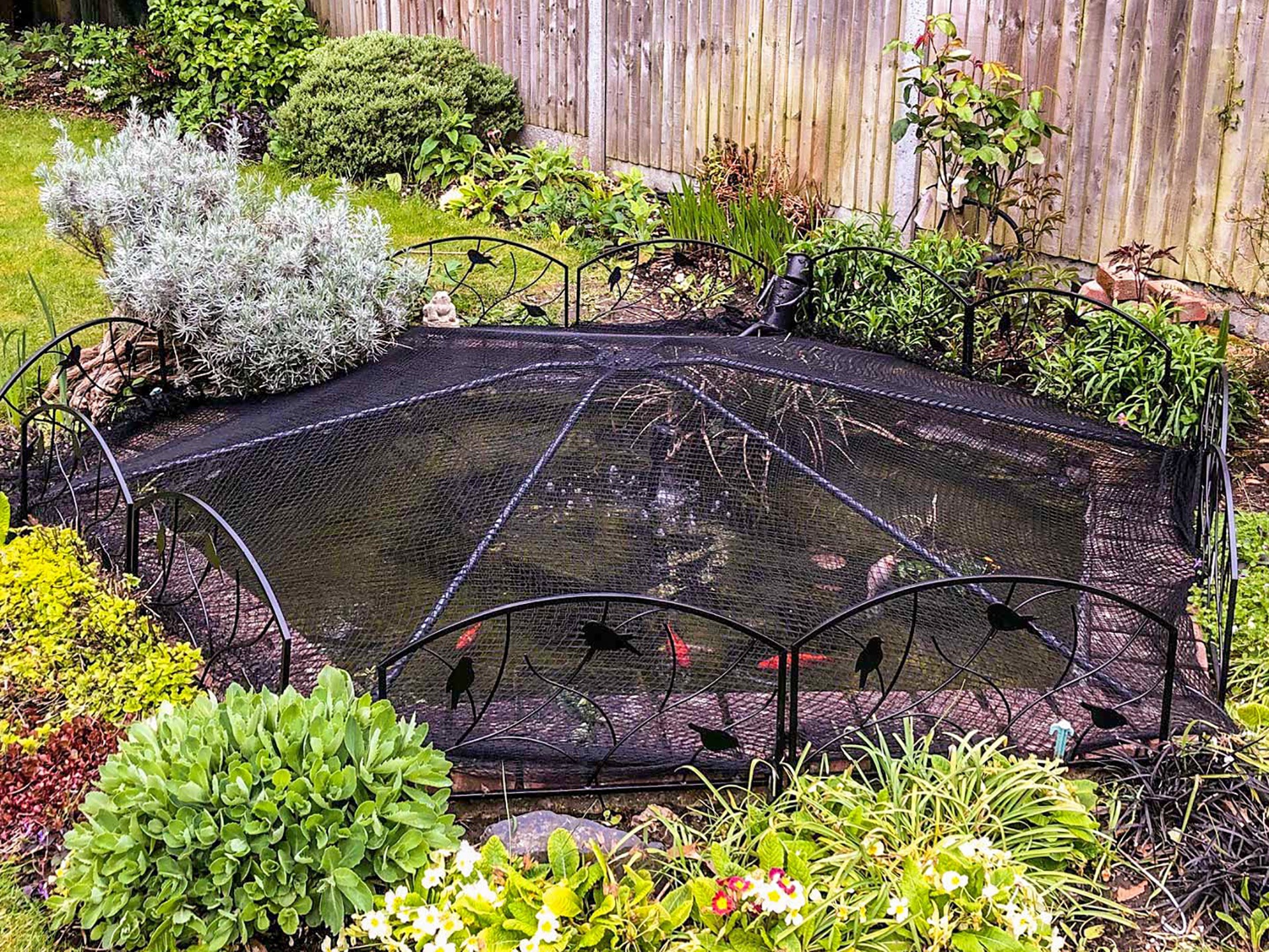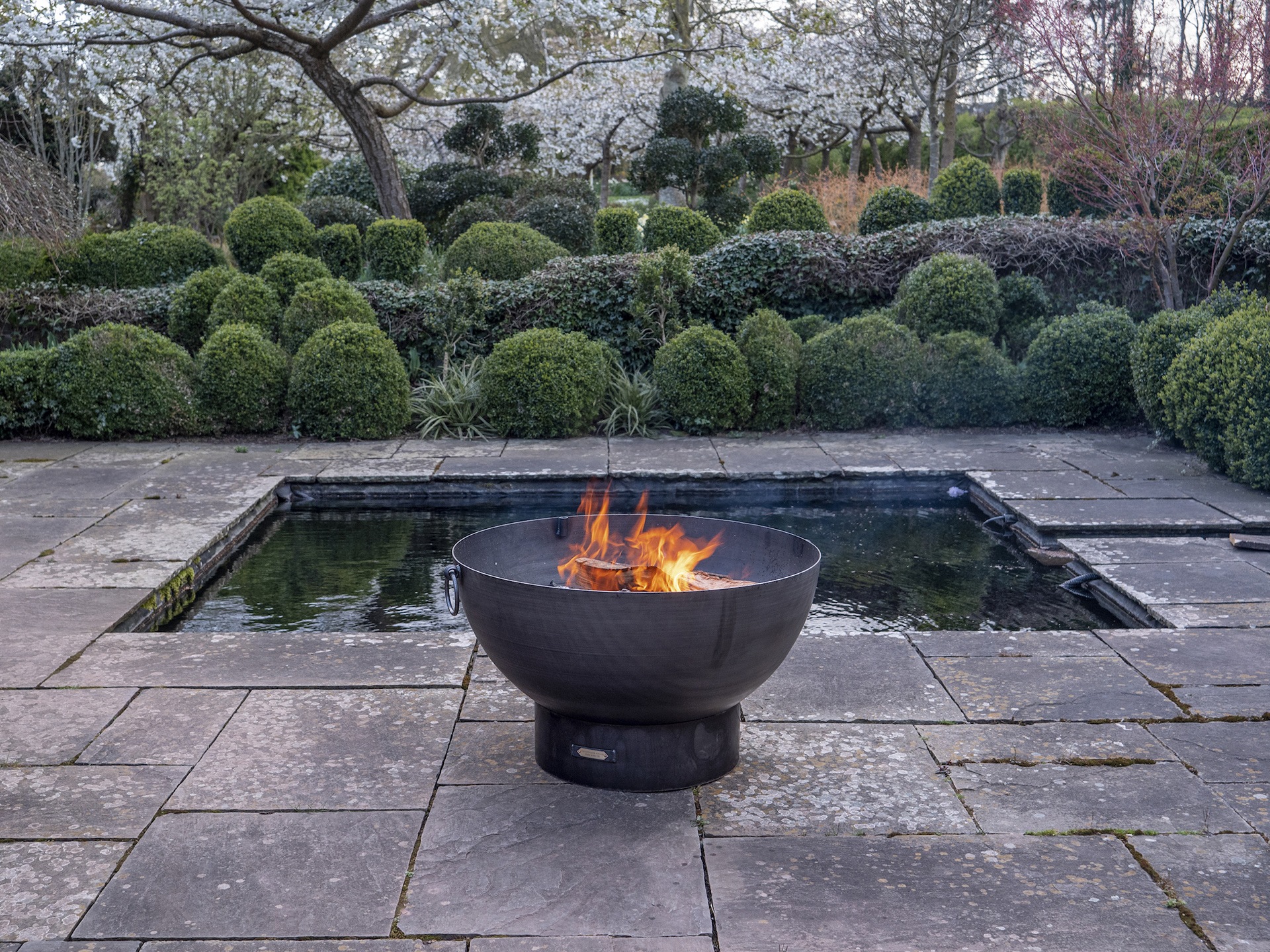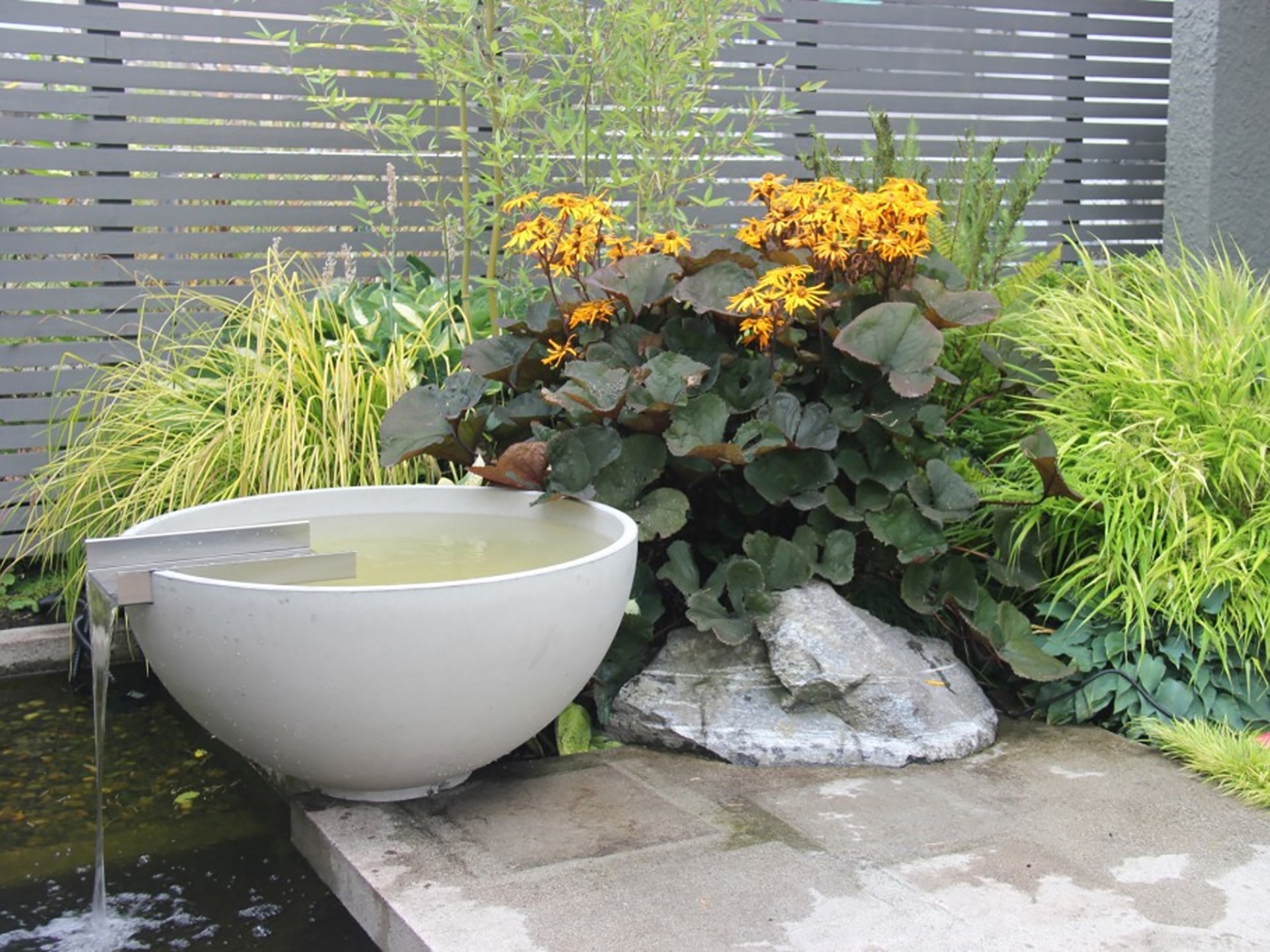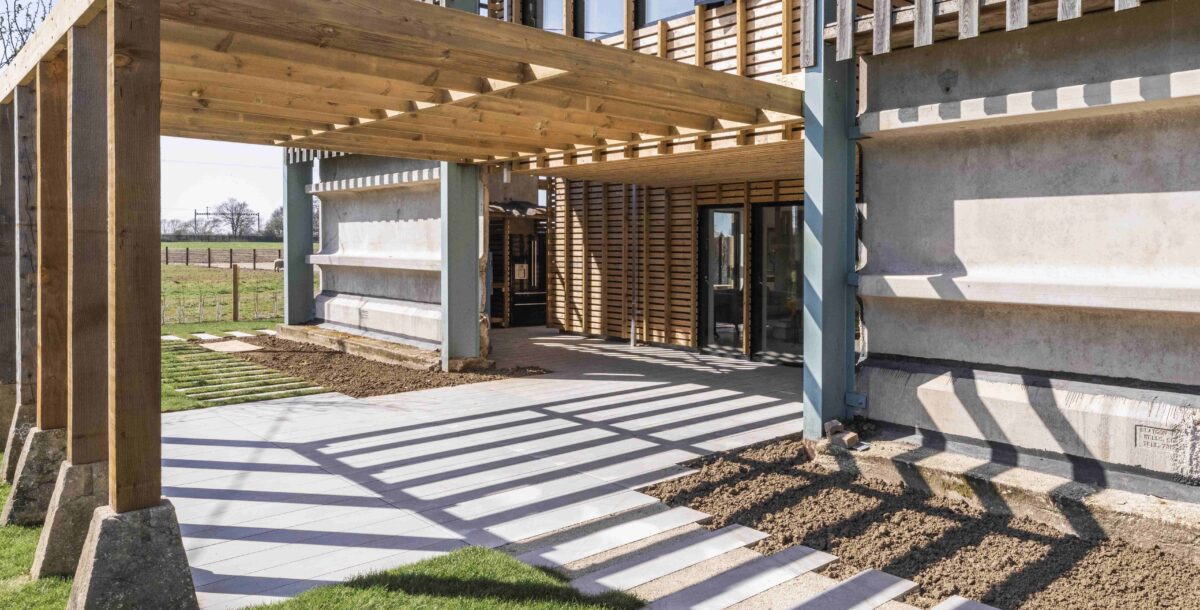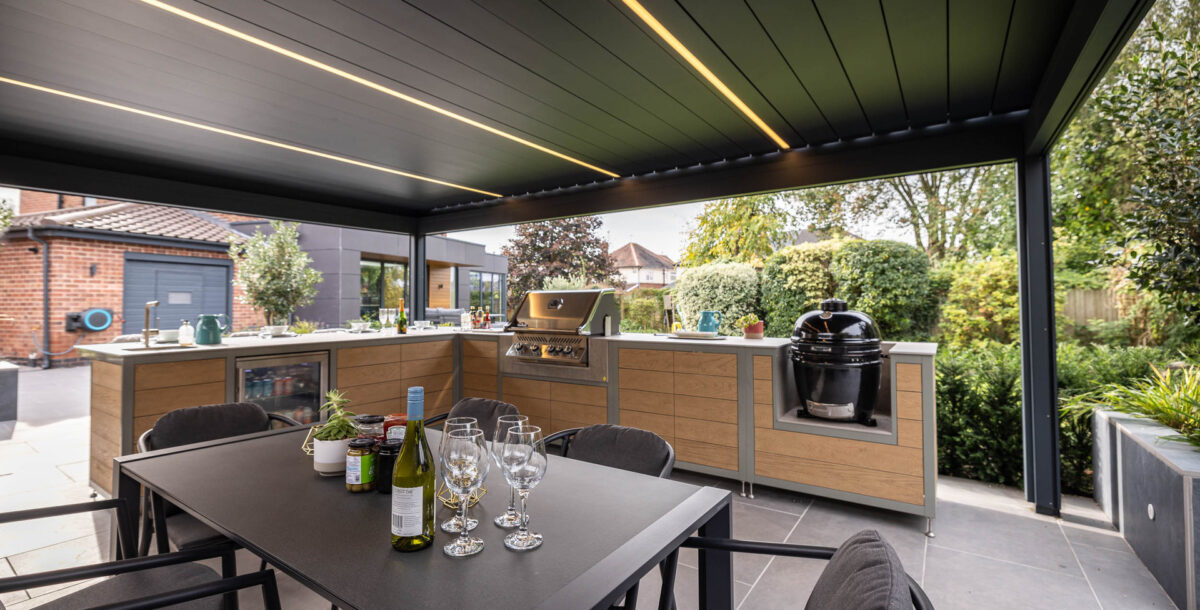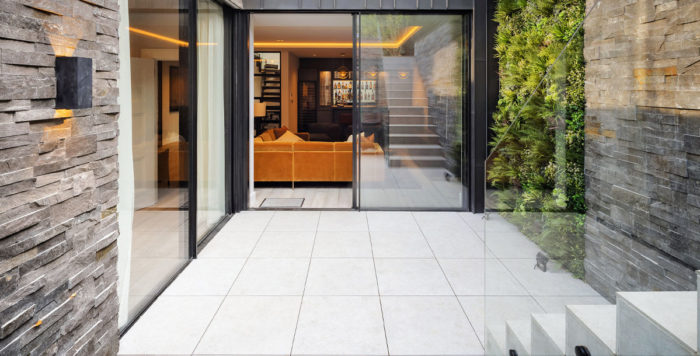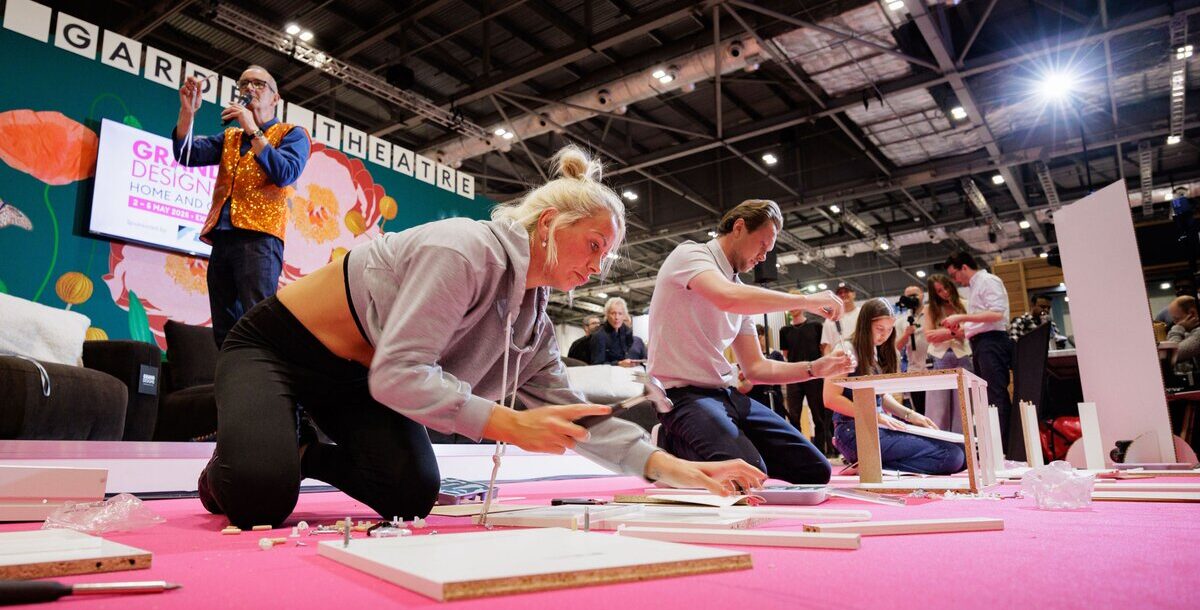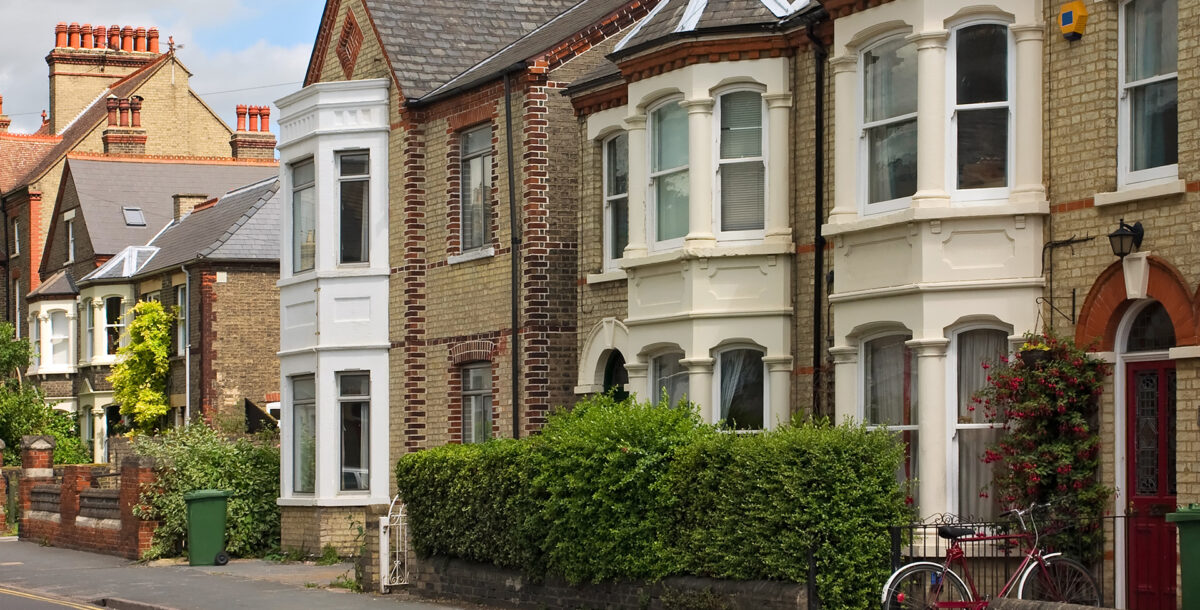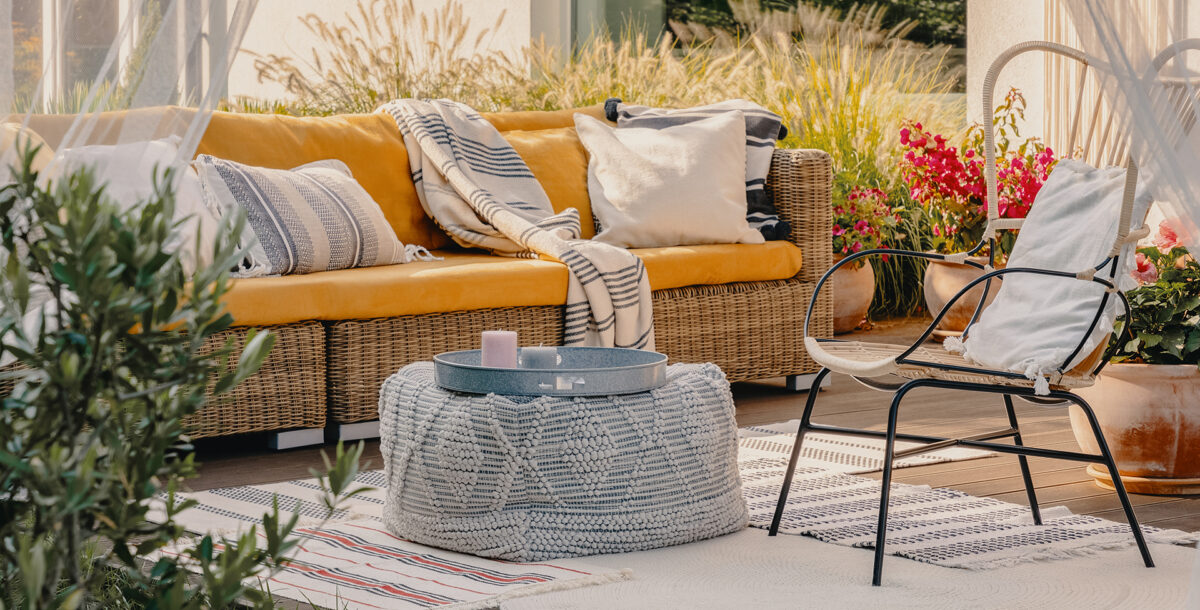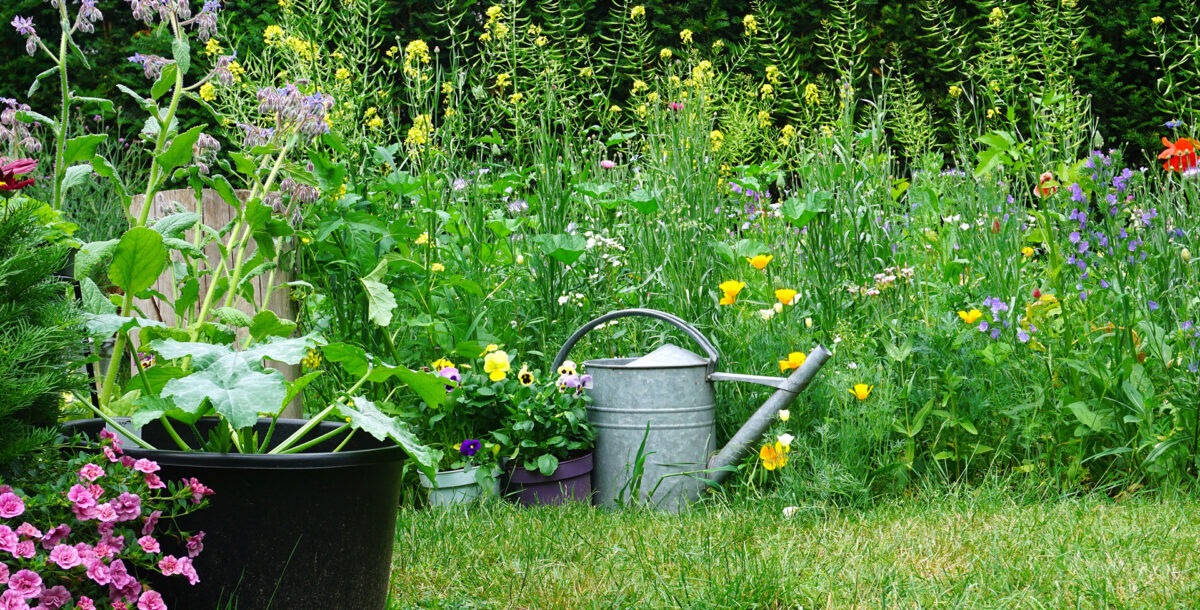How to create the perfect pond
Read on to find out everything you need to know to live your best pond life
A pond can be a source of constant delight in your garden. Whether you choose a formal water feature or a rustic wildlife-friendly pond, it will be an invaluable addition to your outdoor space, creating an area of calm and also adding a vital source of water for wildlife. Getting the right location, shape and features for your garden is important, and a little more complicated than you might think. Fortunately, we’ve spoken to the experts to find out everything you need to know.
Location, location
Victoria Cummins, from planter specialists PlantWhisperer says, “Location is key – look for a spot that gets partial shade, as most aquatic plants don’t like too much direct sun. Make sure the pond will be easily accessible too, for your own enjoyment and your own maintenance.”
Tom Clifford, from garden paving specialists Gardenstone, adds, “Choose an area of your garden that’s level to ensure the water doesn’t run out of the pond, and locate your pond somewhere that is clear from trees and overhanging shrubs so that leaves don’t fall from the trees and gather in the pond.”
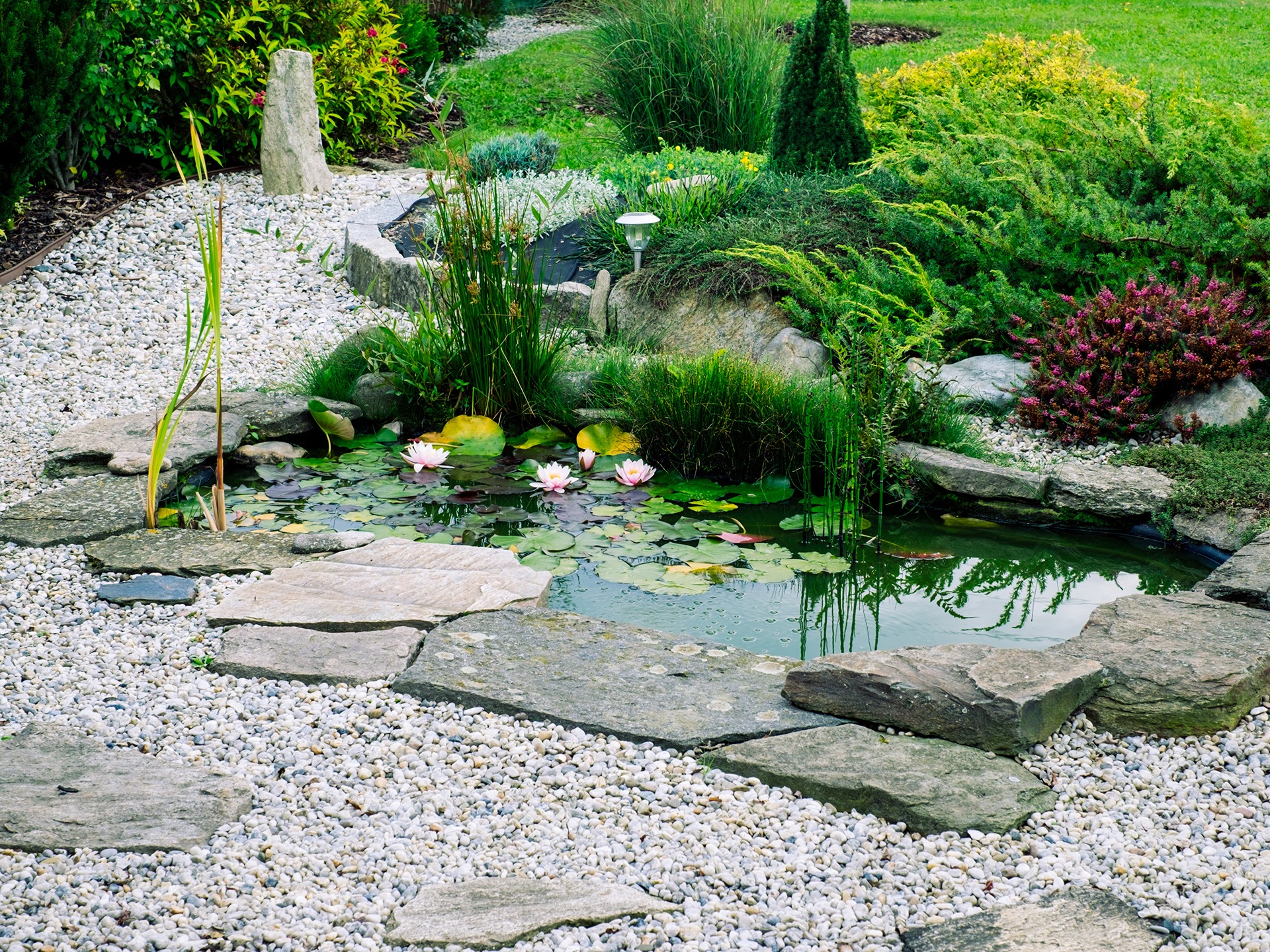
Large, flat stones attract reptiles, who like to sunbathe on the warm rock, but hot stones can be difficult for amphibians who prefer part of a pond to be in the shade. Image credit: Adobe Stock
Victoria continues, “Size-wise, even a small pond can have a big impact. For a thriving ecosystem, I recommend aiming for a depth of at least 60cm in some areas. This allows fish and other pond life to hunker down and survive the winter. Varying the depth also creates different habitats for a greater diversity of plants and creatures.”
Formal pools
If you’re looking for clean lines and minimalist chic, choose a simple geometric shape for your pool. Rigid liners can work well for this type of pool. Look out for ones made from recycled plastic. Installing these is a relatively easy DIY job: just mark out the ground, dig a hole, sink the liner into the ground, and level it. Dig a shallow trench around the edge for the concrete to support the pavers of your choice around the edge. Sustainably sourced or reused natural stone are the environmentally conscious edging choices. Alternatively, there are some very cool porcelain outdoor pavers around that complement a contemporary aesthetic. Just make sure you choose ones that are slip-resistant. There are lots of videos on YouTube that will show you how to make this kind of pond.
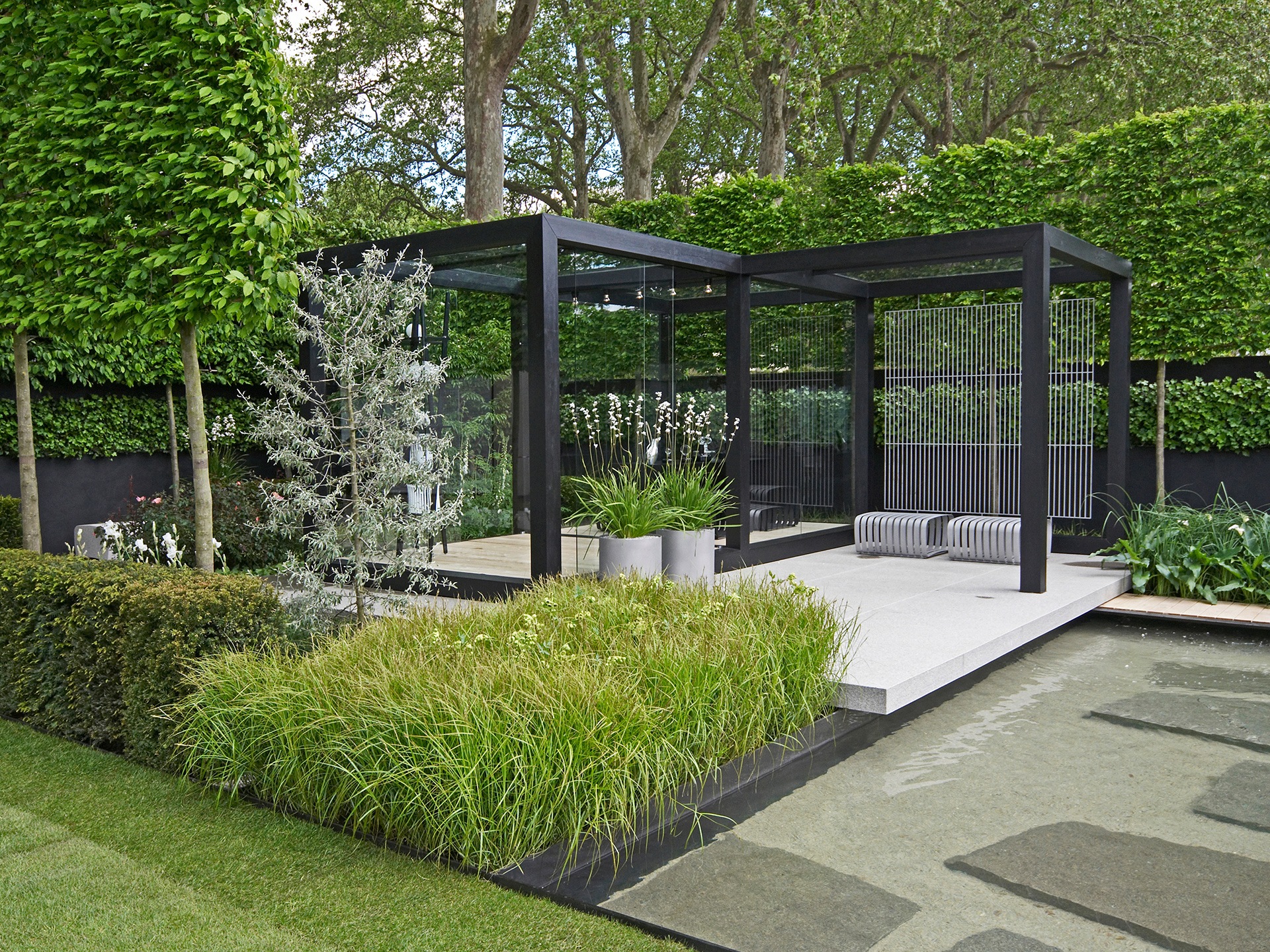
Formal pools tend to have fewer plants than ponds aimed at encouraging wildlife. Image credit: Adobe Stock
You can also use a flexible pool liner to make this type of pond, marking out your chosen shape first with string and pegs, including lines for the different depths. Again you also need to dig a 10cm-deep trench 10cm from the edge of your pond for the concrete to set your edging pavers in.
Or you could consider an off-the-peg pool surround. These consist of pre-cast blocks of pool edging that you sink into the ground and use in combination with a pond liner.
Raised pools
Another formal option is a raised pool. To achieve this look yourself, you build the pond in blockwork to the size and height you prefer, then add an external skin of bricks or stonework to match the look of your garden. Once the pool liner has been laid in the pool it is sandwiched around the edge under another couple of off-courses of bricks. Then the walls of the pond are capped with the stone or brick of your choice. Any brickwork that will end up below the water level needs to be treated with a special sealer to stop it from leeching nasties into the water.
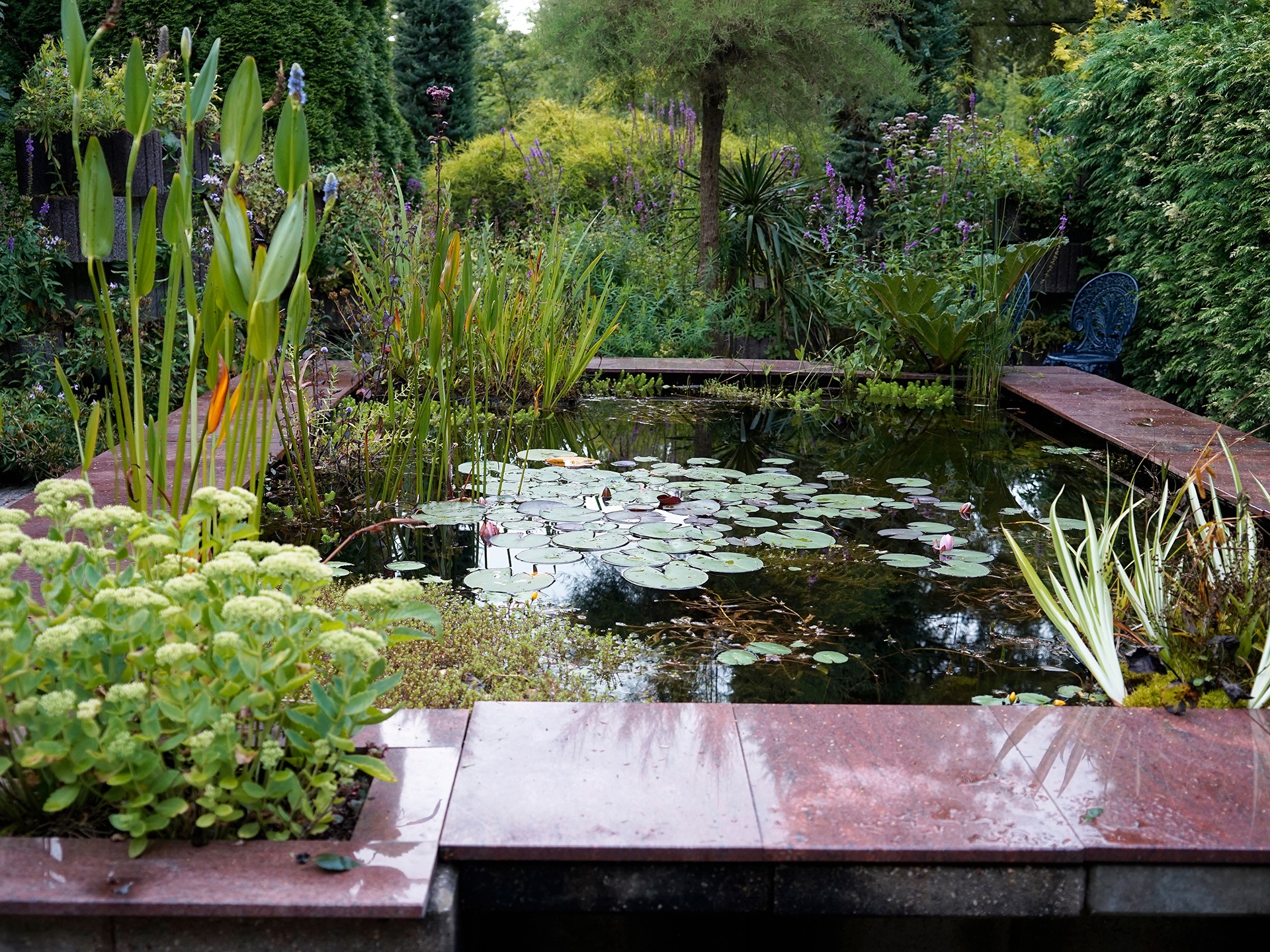
This stunning example full of mature plants shows what a raised pond can look like at its best. Image credit; Adobe Stock
Alternatively, timber-raised pond kits are available for a few hundred pounds. These involve building a pressure-treated timber box and lining it with a pool liner. At the other end of the scale, for a few thousand, what about an elegant, minimalist Corten steel or aluminium pond, available from luxury garden supply companies?
Rills
Rills – narrow channels carrying water from one pond to another – are a very popular garden design feature at the moment. Again, these are easy to build and there are lots of videos online showing you how. Just position with care so you’re not creating a perpetual watery trip hazard.
Water features
Fountains work well in formal pools. Water blades, water spouts and water walls are fashionable choices. Kits for all of them are widely available.
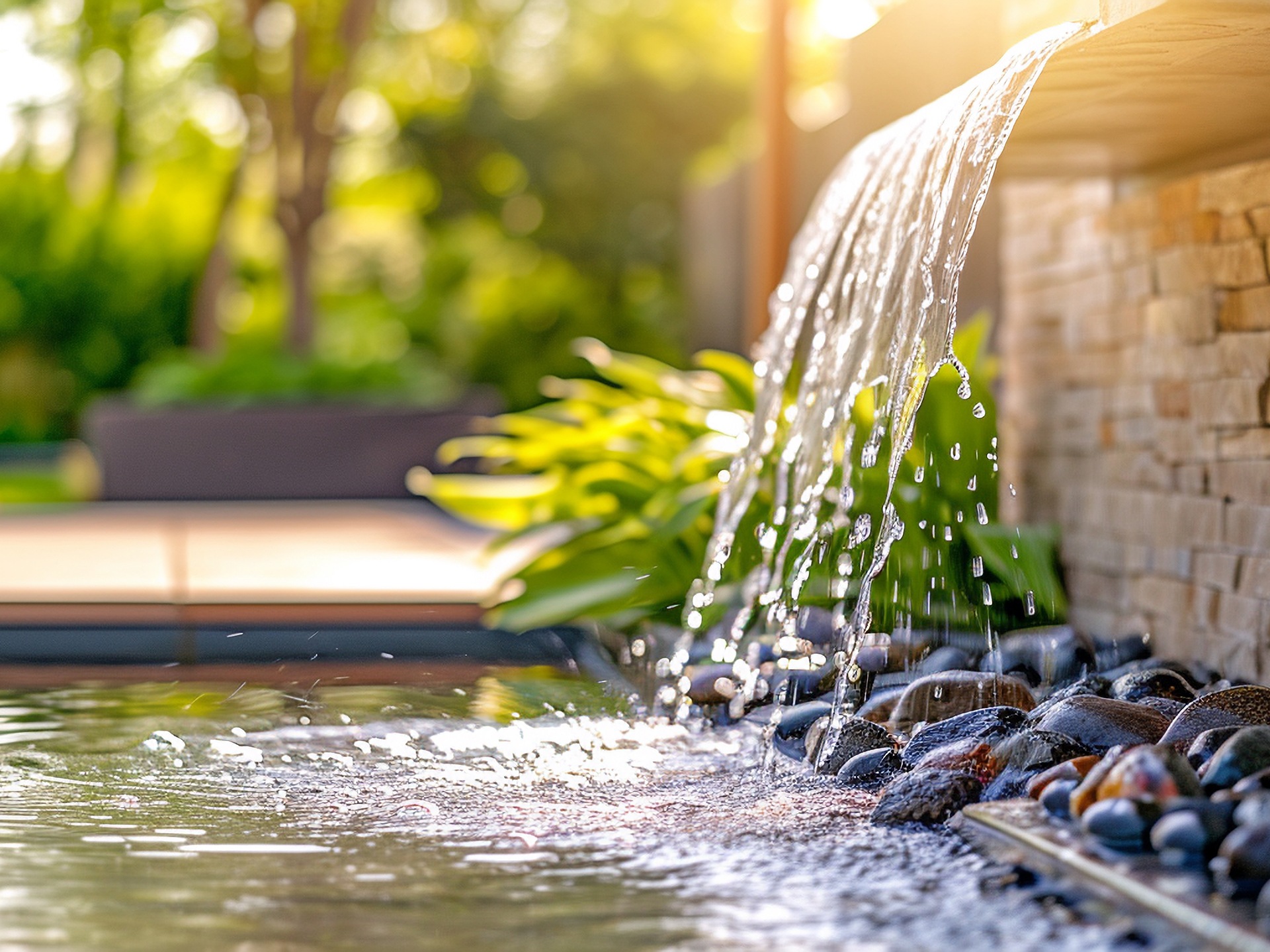
Water blades and water spouts attached to walls beside ponds are contemporary water feature choices. Image credit: Adobe Stock
But, whatever style you choose, if you want to add anything grander than a small solar fountain, talk to an electrician at an early stage of the project about the best way to get power to your water feature.
Lighting
Think about lighting too. The right lighting can really enhance a formal pool and there are some brilliant LED, underwater and floating options available. Solar lights have come on in leaps and bounds and work better than ever.
Speaking of talking to experts, if you have the budget for a grand pond design, approach local garden and landscape design companies and ask for their ideas rather than giving them a very specific brief at the outset. They are the professionals and will likely have ideas that you couldn’t have envisaged.
Wildlife pond
The cutting edge of garden design lies in the rewilding movement. This show garden from RHS Chelsea Flower Show 2024 gives you an idea of what this looks like. At the same time, more and more people are interested in encouraging nature into their gardens. A wildlife pond can be a great way to do this – and stay on trend.
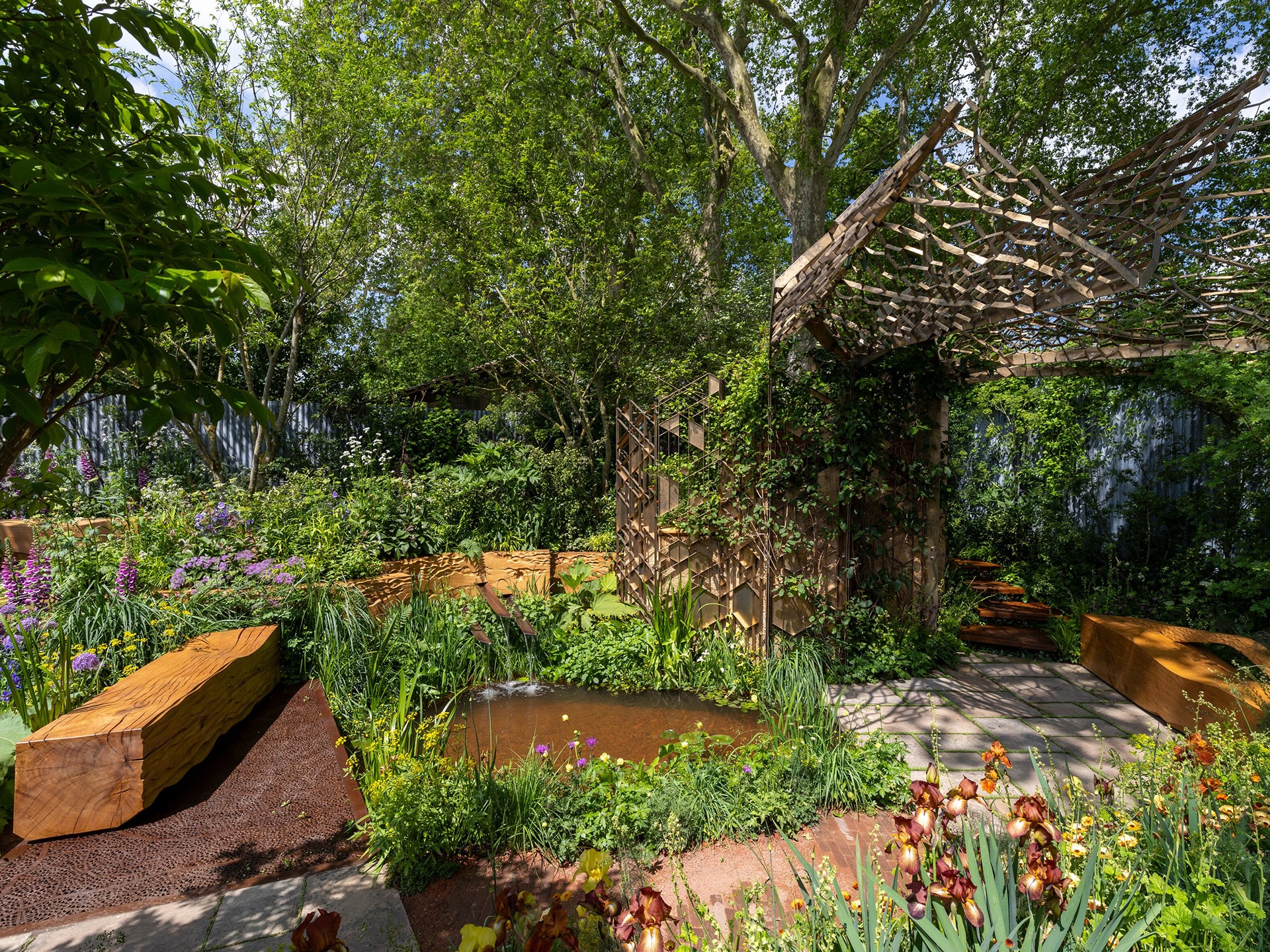
Stunning example of a pond in a wild garden setting from Chelsea Flower Show 2024: The Octavia Hill Garden by Ann-Marie Powell and Blue Diamond with the National Trust. Image credit: RHS/Neil Hepworth
An informal wildlife pond can be any irregular shape – you can try out shapes using a hose or string on the ground. This type of pond is made using a flexible liner held in place around the edge with stones, pebbles, planting and turf rather than pavers. Gently sloping sides let amphibious creatures clamber in and out with ease. Plants can be planted into a layer of mud in the pond rather than in baskets, which means the sides of the pond can be sloped rather than needing to be stepped. The mud needs to be low-nutrient, made from something like special aquatic compost.
The excellent RHS book How to Create a Wildlife Pond by Kate Bradbury has everything you need to know to build one yourself.
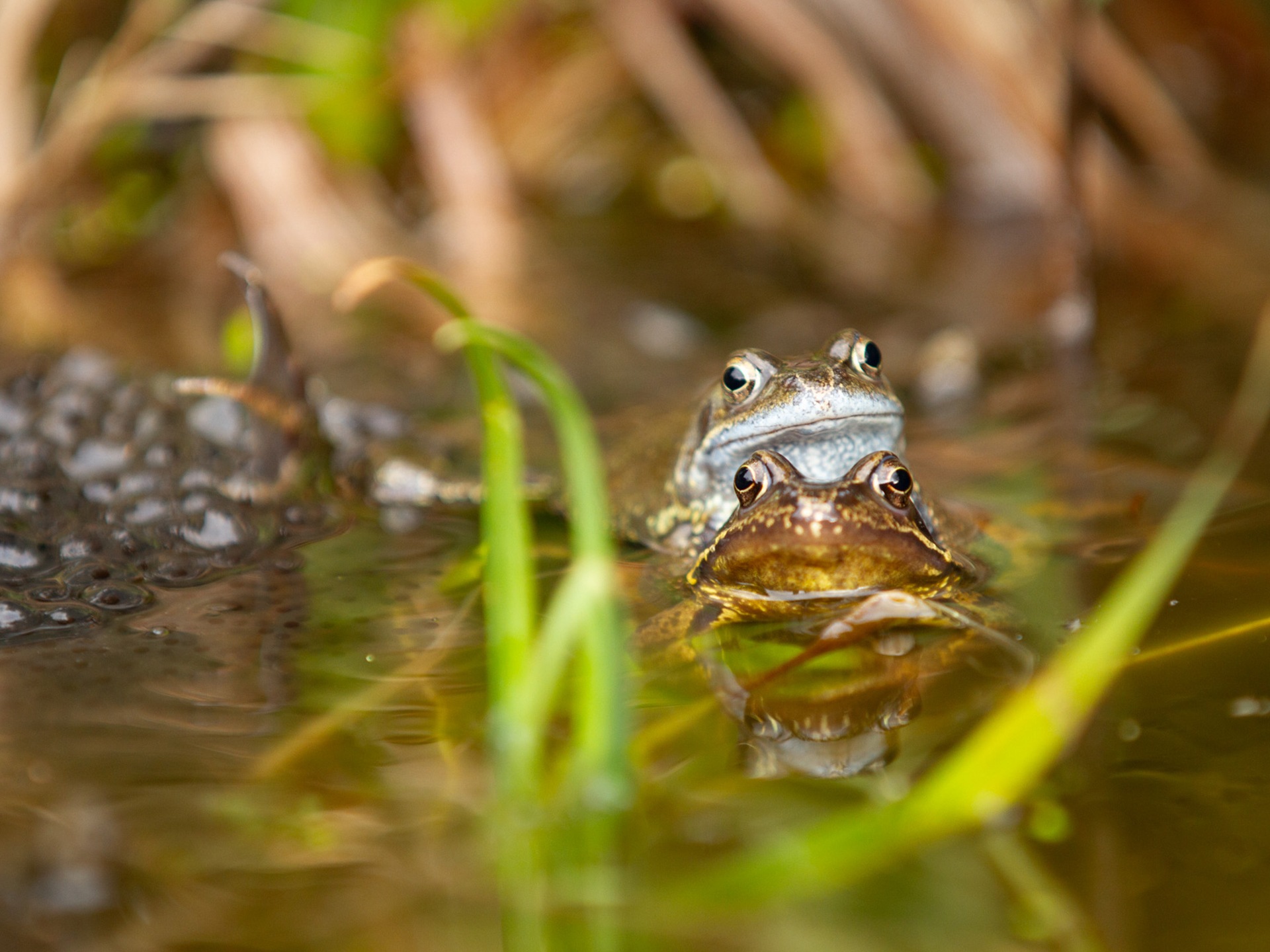
Frogs, toads and newts are dependent on ponds to breed. Image credit: Sean McMenemy Ark Wildlife
There are lots of extras you can add to your pond to make it more wildlife-friendly. A pebble beach is perfect for tadpoles. Plants around the edge provide cover from predators for the smaller creatures. A branch arching across the pond will make a great perch for dragonflies as well as birds. Just be careful not to puncture the pond liner when you stick it into the ground. Even if you are making a formal pond with steep sides and a paved surround, adding a wildlife escape ladder or just a pile of bricks will let wildlife get out of the water.
Safety
Remember that ponds can be hazardous for small children, so if you have young visitors to your garden regularly, think about installing a fence around your pond. And always supervise youngsters near water.
Pump
Unless you are planning to put fish in your pond, there is no need to have a pump. Oxygenating plants and regular cleaning out of debris should be enough to keep the water healthy. You can always add a cheap solar fountain if the water quality does start to deteriorate.
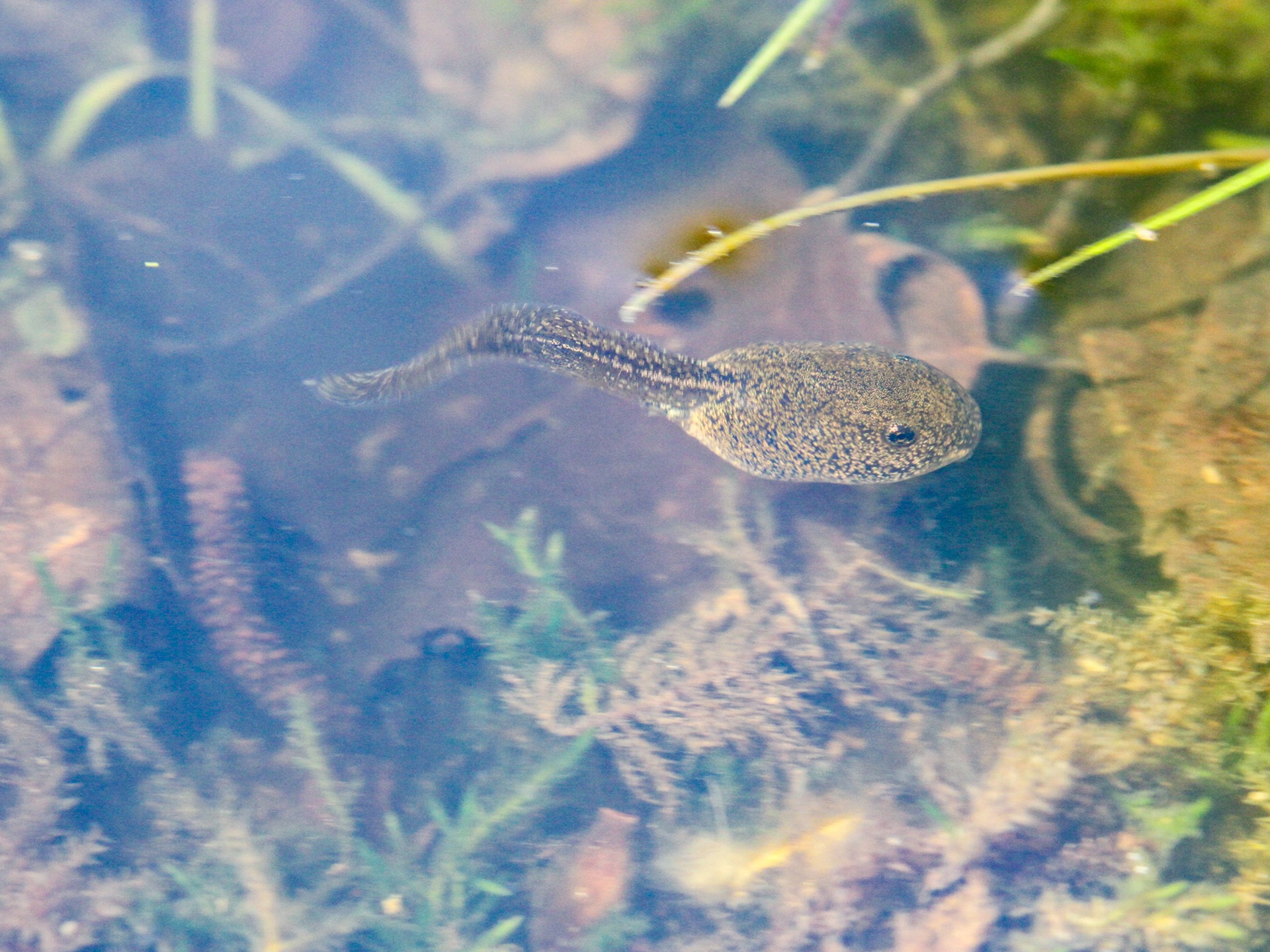
Creating the right conditions for tadpoles to thrive is one of the most satisfying aspects of making a wildlife-friendly pond. Image credit: Sean McMenemy Ark Wildlife
Liners
Pond liners are available in rubber, PVC and synthetic rubbers such as butyl and EPDM. These are not particularly environmentally friendly materials. However, if you buy a good quality liner and use it with a proper underlay (rather than sand, newspaper or old carpet, which will all perish and/or are simply not up to the job) your pond should last 25 years– and could be very beneficial to local wildlife during that time.
Clay-lined pond
For large ponds and lakes, another sustainable option is to line them with clay. This is a traditional, environmentally friendly method that involves ‘puddling’ – trampling down – damp clay in the bottom of the pond to remove the air and form a thick layer. It’s hard work and not necessarily cheap. You can find out all about it in this great blog post here. One final option for large ponds and lakes is bentonite clay liner – clay sandwiched between geotextiles.
Profile
If you are going to plant your water plants in baskets you will need shelves – steps – of different depths: deepest – say 60cm – in the middle, with one or two stepped shallower shelves around the edge where you can put the different types of aquatic plants in their planting baskets. Alternatively, you can plant your plants directly into a low-nutrient substrate at the bottom of the pond. In this case, you can do away with the steps and just have gently sloping sides.
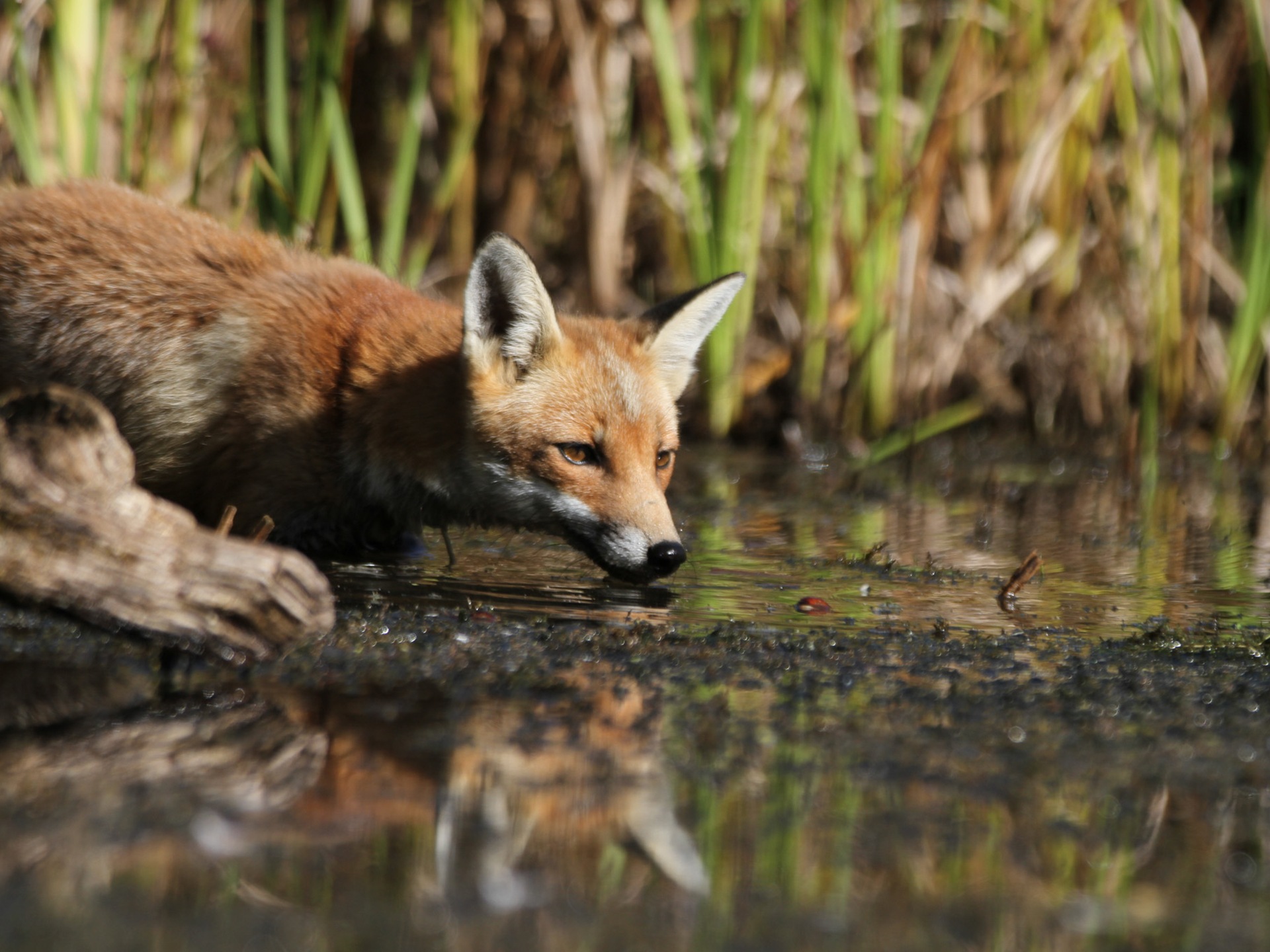
Image credit: Sean McMenemy, Ark Wildlife
Filling your pond
When the time comes to fill your pond, it’s not as simple as just turning on the tap. Tap water contains additives that make it less than ideal for pond life. Victoria says, “Ideally you should use rainwater to fill your pond, as tap water can contain chemicals that can harm both plants and animals. If you have a Water Butt this is the perfect opportunity to use the collected water to fill your pond, however, if you use tap water you may have to wait two to three weeks until you place plants in the water.” You can also buy water-treatment products that make tap water suitable for ponds.
Sean McMenemy, from Ark Wildlife, says, “When your pond is just starting out adding a bucket of water and sludge from the bottom of a friend or neighbour’s pond will introduce all manner of invertebrates and draw in nearby creatures. Soon enough you can expect to see dragonflies showing off their aerial acrobatics, as well as frogs, newts and toads taking up the residence. Pond skaters and diving beetles have an incredible ability to find and colonise new ponds. Birds will swoop down to bathe and drink, and if you’re lucky you might even get visiting hedgehogs, foxes and other mammals.
Plants
Sean has lots of advice on picking plants. He says, “Plants are vital for any pond. They stop the water from going stagnant, attract a myriad of creatures, produce shelter for bathing birds, and protect water-based creatures like tadpoles, newts and dragonfly larvae from predators. Equally important, many pond plants are attractive and bloom with spectacular flowers for us to enjoy.
“Native pond plants can grow quite large and become invasive. They are great for larger ponds, but smaller ponds and water features will benefit from water plants that have been specifically bred to remain dwarf. There are wonderful examples of miniature water lilies, for example, and frogs won’t discriminate between native and non-native species as they sit croaking on floating lily leaves on a summer evening.
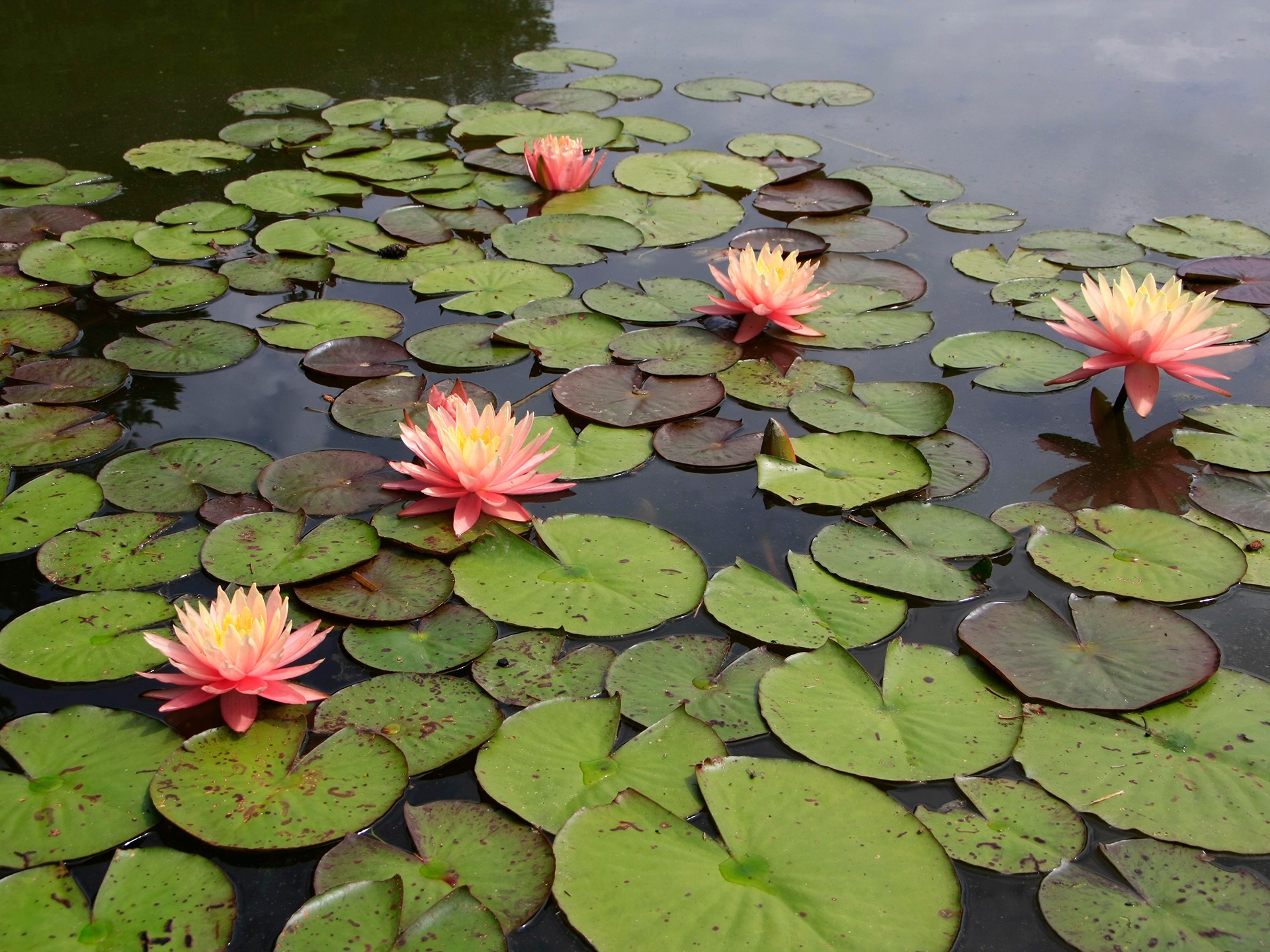
Waterlilies work well in formal pools and large wildlife ponds. Image credit: Adobe Stock
“There are different classes of plants including oxygenators, emergent and marginals, and you will need one or more of each kind. Oxygenators are critical. The plants live below the surface gently bubbling oxygen into the water keeping it fresh. Canadian pondweed works well in small ponds. In larger ponds, it would be better to use native plants such as Hornwort, Water Soldiers, or Water Starwort.”
Sean continues, “Emergent plants bury their roots at the bottom of the pond, using up all the detritus that would otherwise allow ugly algae and blanket weeds to overwhelm the pond. Plants such as Arrowhead, Bog Bean, Flowering Rush and Lesser Reedmace are beneficial and quite attractive flowering.
“Finally, marginals like Brooklime, Cotton Grass, Ragged Robin and Yellow Flag Iris are a great option if space allows. There are all kinds of varieties out there in every shade and colour to fit your perfect garden canvas. They can be planted directly, or in pots or troughs, but remember they are all water-greedy and need constantly wet roots. These plants finish the pond and blend it into the rest of the garden as well as providing food, habitat, and cover for pond dwellers like frogs, newts, dragonflies and damsels.”
Container pond
It’s possible to make a pond in even the smallest space. A barrel (new rather than an old one, as the previous contents of a reused one could leech into the water causing problems), water trough, Belfast sink or purpose-made pond container all work well. You won’t attract the same variety of wildlife but can enjoy water plants and will attract some invertebrates as well as offering birds a handy place to drink. The RHS has a nice guide to making one here.
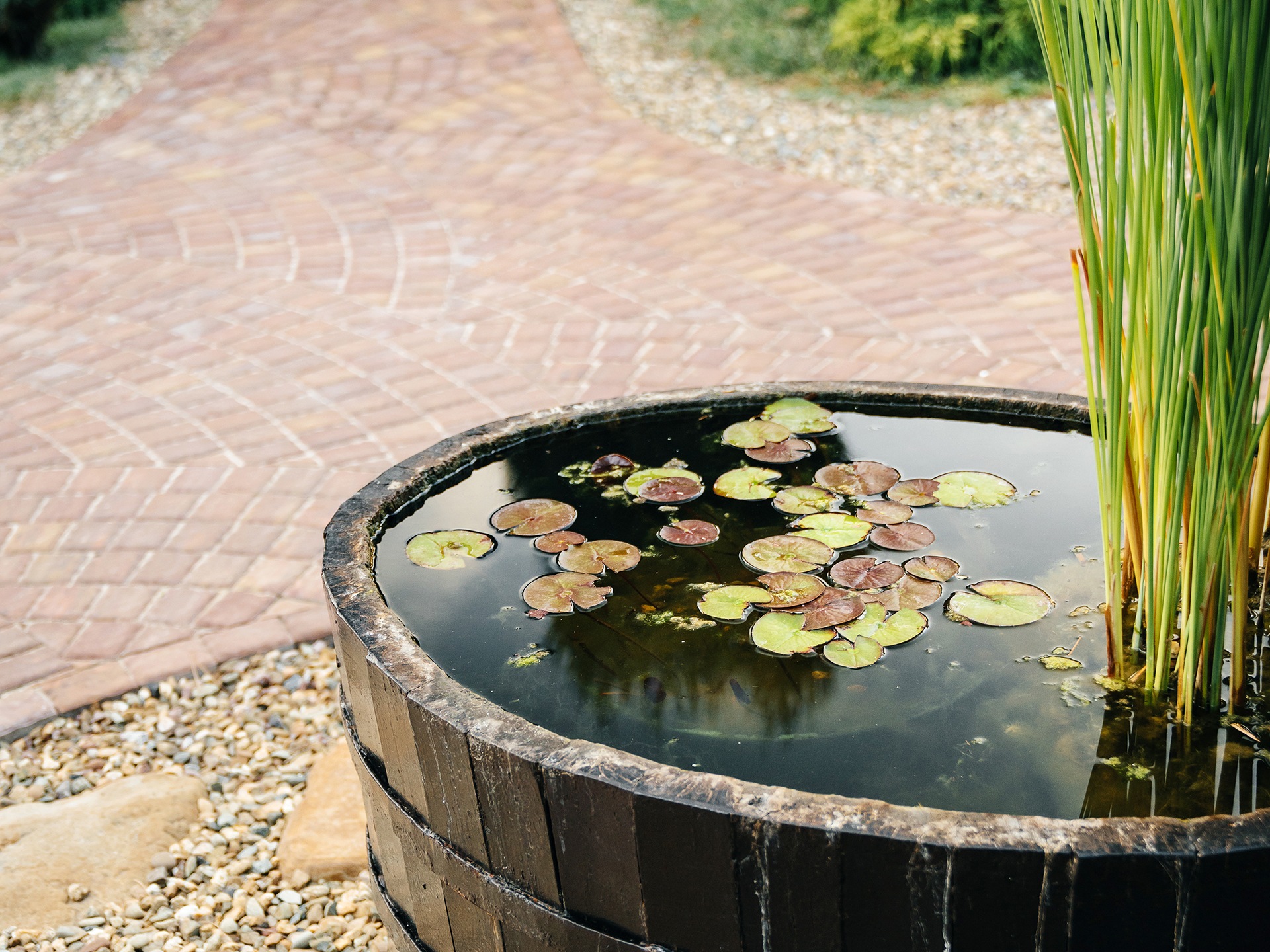
Miniature water plant varieties work well in container gardens Image credit: Adobe Stock
Sinking your container pond into the ground will make it more wildlife-friendly by avoiding big fluctuations in the temperature of the water. If you’re planning on sinking your pond into the ground, you could even use an old bath. Just make sure you have a plug (obviously) and seal with some waterproof sealer. Or cover the hole with a patch of pond liner using a waterproof sealer.
A container pond will sit happily on a patio, roof terrace or even a balcony. You will still be able to enjoy water plants and some invertebrates, even if it’s not big enough for larger amphibians.
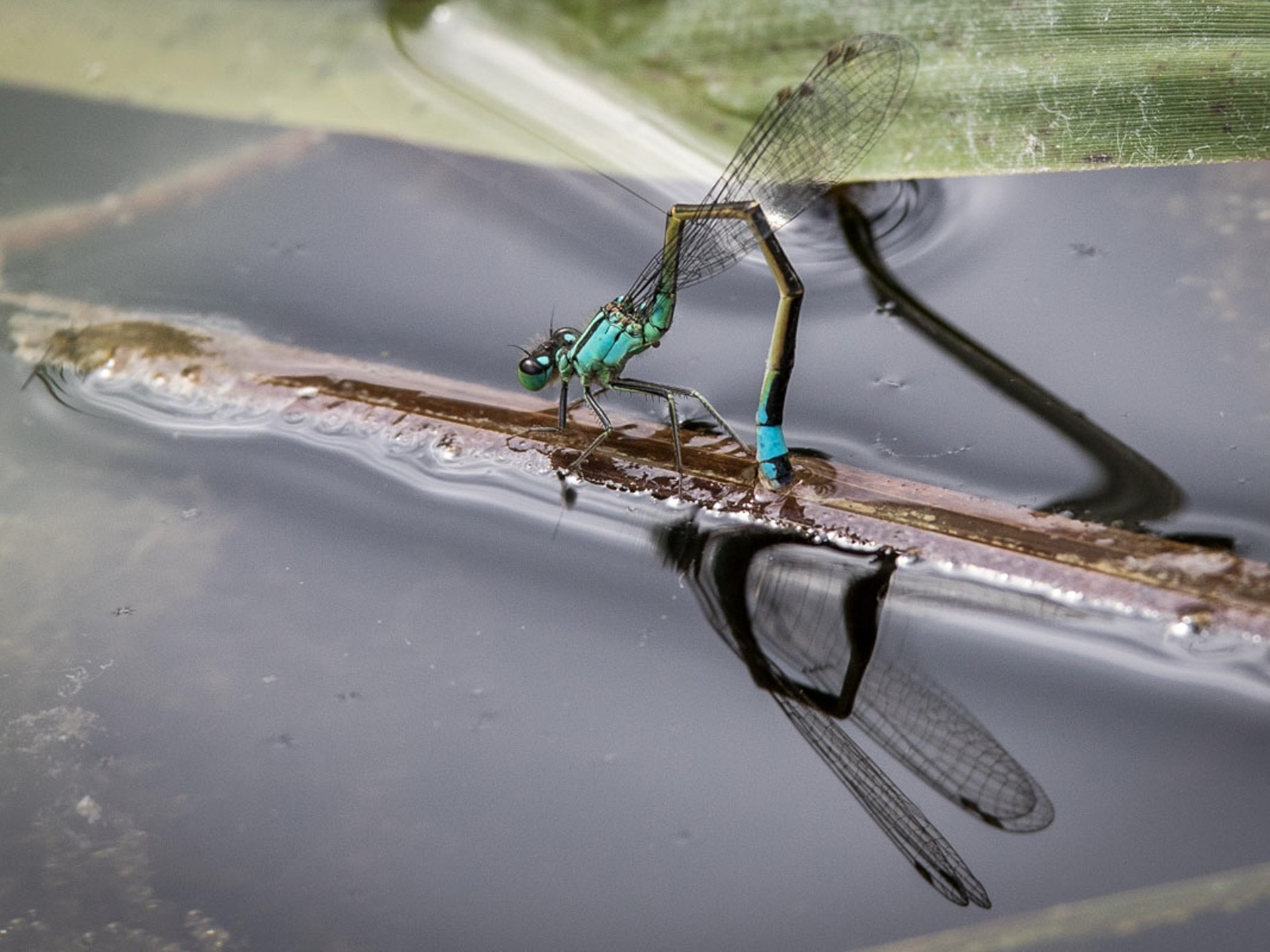
Image credit: Sean McMenemy, Ark Wildlife
Fish
Fish work well in formal ponds, but they are not such as good idea if you want to encourage other types of wildlife into your pond – because they tend to eat it! Goldfish will likely eat most of the invertebrates in a small garden pond. Plus, if you have fish, you’ll need a pump to aerate the water, because all the fish poo and uneaten food have an adverse effect on water quality. If you definitely want fish, consider having two ponds: one with the fish in and another for other forms of wildlife. Koi have very. particular needs that are quite different from the conditions provided by a standard pond. They need deeper water for example, and no rocks and plants.
Maintenance
Nutrient-rich water sounds like it might be something positive. But actually it’s a bad thing: it’s what happens when too much plant debris and animal waste collect in the water and it can lead to algae and duckweed taking over. So you need to clear out leaves and other debris that fall into your pond regularly to keep its ecosystem healthy. Remove any blanketweed and duckweed that build up too. Rinse them first in a bucket of water to catch any tiny creatures caught up in the weed so you can return them to the pond.
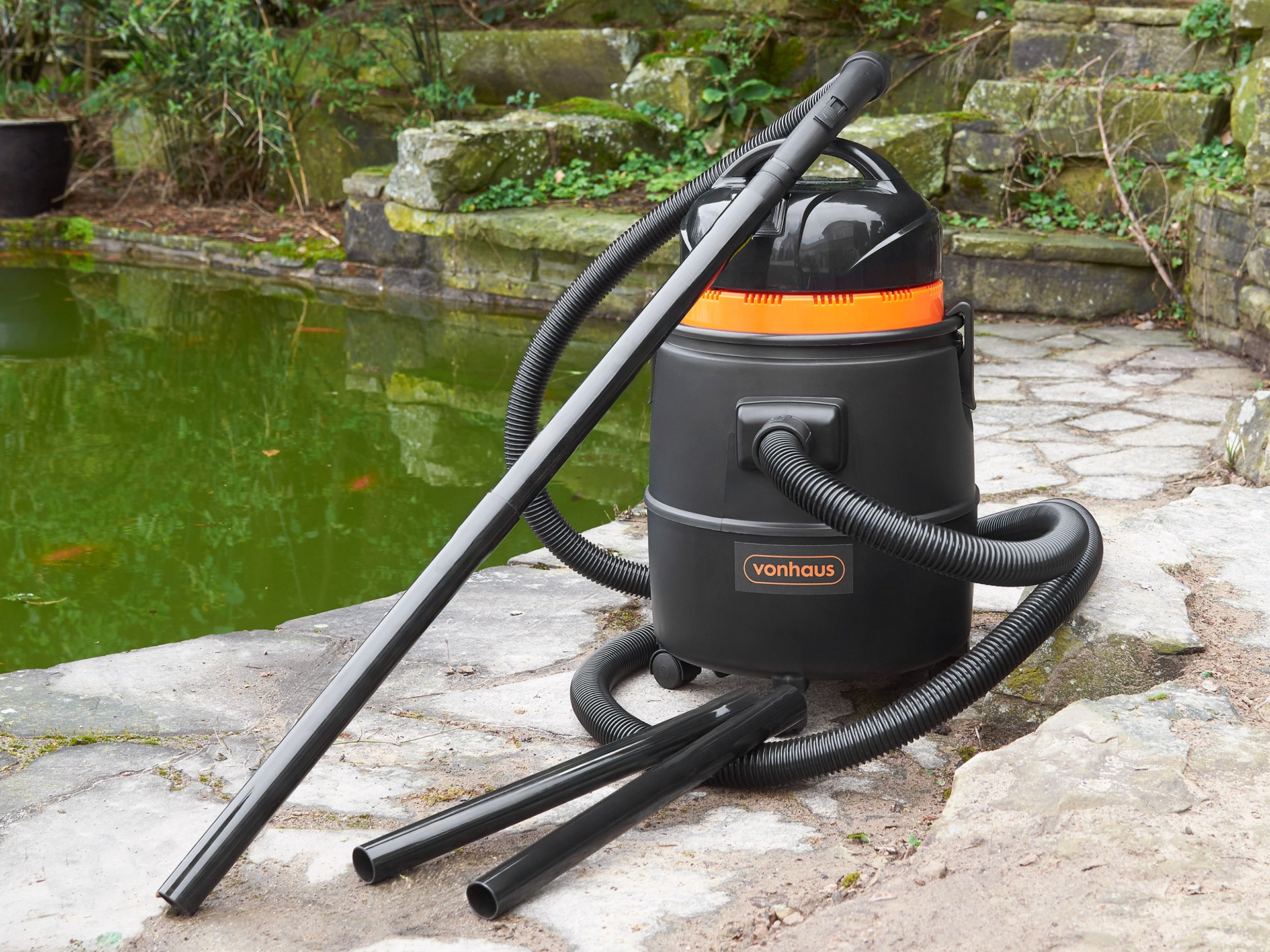
Some people choose to clean the debris from their pond using a wet and dry pond vacuum like this one from Vonhaus, £94.99, which has an algae brush attachment
Swim pond
If money is no object, what about the ultimate pond – a swimming pond like the one we all remember from Nina and Dan’s Chichester house on the show? There are several companies now offering these natural swimming ponds, which are in fact two pools with separate areas for wildlife and swimming.
More information
Here are a couple more great sources of information:

